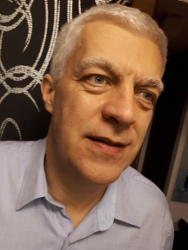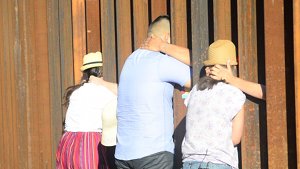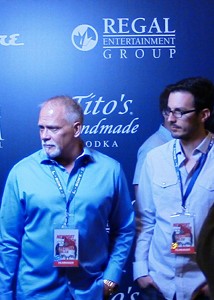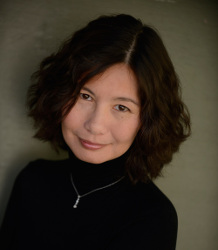Posted by Elena del Valle on August 2, 2018

Theatrical one-sheet for Generation Wealth – click to enlarge
Photo, video: Lauren Greenfield, Amazon Studios
After 25 years as a photographer and filmmaker Lauren Greenfield became convinced that there was a theme to much of what she had observed. She felt a culture of wealth bound many of the images. She mounted a photographic exhibit of her work, published a book and released Generation Wealth, a 106-minute introspective film released via Amazon Studios. Scroll down to watch the film trailer.
The director and her family appear prominently in the film. She interviews them as well as people she knew in her high school years and the subjects of previous films and photography projects.
Questions about the film submitted via email to a representative remain unanswered as of this writing. The film was written by Greenfield who was also a producer. Frank Evers and Wallis Annenberg were also producers. Theater locations and additional information are available on the film website, generationwealthmovie.com
Greenfield is an Emmy-award-winning photographer, filmmaker, and chronicler of youth culture, gender, and consumerism. Other films by Greenfield include Queen of Versailles and Thin. The film was supported by a grant from the Sundance Institute Documentary Film Program with support from JustFilms and Ford Foundation Cinereach Project at Sundance Institute.
Posted by Elena del Valle on June 27, 2018

Eating Animals – click to enlarge
Photo, video: Courtesy of Sundance Selects. A Sundance Selects release.
Ever wonder where you eggs, dairy and meat come from? The makers of Eating Animals, a 94-minute film based on a book of the same title by Jonathan Safran Foer, went in search of answers. Over five years they visited farms, spoke with farmers, professors, industry experts, activists, and whistle blowers. They filmed in California, Nebraska, Iowa, North Carolina, China, Germany, India and Sweden. They imply that the factory farming practices of recent decades have degraded our humanity by making us part of the inhumane treatment of animals, polluted our environment and put our health in jeopardy. For animals lovers some scenes and images may be difficult to watch or forget. Scroll down to see film trailer.
Directed and produced by Christopher Quinn (Sundance award winner God Grew Tired of Us), the film was produced with Academy Award winner Natalie Portman (who also narrates it) and Foer. It indicates that nearly all Americans eat animals products produced in factory farms and that 30 states have passed Ag Gag laws to limit information and images of the harmful factory farming practices. The film opened in New York City June 15, 2018 and will roll out in theaters nationwide in the coming weeks. Information is available at the movie website Eatinganimalsmovie.com.
A statement about the film says: “Eating Animals aims to alter the very frame of public discussion about industrial agriculture and the future of meat, shifting media debates, minds, and markets alike. Moving past any sense that factory farming is a concern only for animal or environmental activists, we paint a vivid portrait of how industrial agriculture unraveled core national values and changed the world for the worse. The fight to end factory farming emerges not only as a fight to eliminate what may be the greatest crime against animal life ever committed, but as a commonsense and economic necessity.”
The film was made by Big Star Pictures in Association with Artemis Rising Foundation and The Neuman Family Foundation. Funding was provided by Obvious Group, LLC, Annenberg Foundation, Artemis Rising Foundation, Neuman Family Foundation, Jivan Fund, LLC, Simone Friedman, Samir and Puja Kaul and William Bettman.
According to promotional materials for the film the book Eating Animal is the only book in the category “animal rights” besides Peter Singer’s 1973 classic Animal Liberation that has remained a top ten Amazon bestseller since 2009; the U.S. version of the book has sold 400,000 copies and the book has become an international bestseller with language rights sold in 27 countries.
Click to buy Eating Animals
Posted by Elena del Valle on January 8, 2018

János Mészáros, author, Kings and Crosses
Photo: János Mészáros
A podcast interview with graphic novel author János Mészáros is available in the Podcast Section of Hispanic Marketing & Public Relations, HispanicMPR.com. During the podcast, he discusses Kings and Crosses with Elena del Valle, host of the HispanicMPR.com podcast.
János, who writes under the pen name Sinonimo, is owner of Libub Group Kereskedelmi És Zolgátató Kft. He spent over 20 years in management consultancy in Hungary and across Europe. Kings and Crosses is his first fiction work. He created the story and the story board for the graphic novel.
To listen to the interview, scroll down until you see “Podcast János Mészáros” on the right hand side, then select “HMPR ” and click on the play button below or download the MP3 file to your iPod or MP3 player to listen on the go, in your car or at home from the RSS feed. Some software will not allow flash, which may be necessary for the play button and podcast player. If that is your case, you will need to download the file to play it. To download it, click on the arrow of the recording you wish to copy and save it to disk. The podcast will remain listed in the January 2018 section of the podcast archive.
Posted by Elena del Valle on November 1, 2017

A scene from El Mercado de la Inocencia
Photo, video: Discovery en Español
At 10 p.m. E/P this Sunday November 5 Discovery en Español will air for the first time El Mercado de la Inocencia, a one hour Spanish language documentary (44 minutes of documentary) about sex tourism in Medellin, Colombia, as part of the Discovery a Fondo investigative programming block. The program, often featuring dark scenes filmed with what appear to be hidden cameras, focuses on the former drug trafficking and extreme violence destination now an international capital of sex tourism, including the sale of underage sex. Scroll down to watch a video clip in Spanish.
According to promotional materials, many of the illegal networks run by foreigners in the United States and Europe offer Medellin guided tours with underage prostitutes in their packages available for online purchase. Narrated and directed by David Beriain, a journalist and researcher known for his work on Clandestino’s, the project was headed by Michela Giorelli, Rafael Rodriguez and Carlos Cediel. The program was produced by 93 metros, an independent Spaniard production company, earlier this year and required six months to produce. A Discovery en Español spokesperson declined to share any information on production costs.
“No, we did another documentary about sex tourism in Cartagena a few years ago,” said Michela Giorelli, vice president, Production and Development Discovery Latam/USH, when asked by email via a publicist if this is the first time the network airs a documentary about sex tourism. “We have also explored the subject with ‘’Trata de mujeres: de Tenancingo a Nueva York’’, an Emmy Award winning documentary about sex trafficking that aired as part of Discovery a Fondo, the networks’s investigative programming block.” When asked if anyone in the film was compensated financially to participate (be video or audio taped or interviewed), she replied, “No, nobody is ever compensated in our investigative documentaries.”
According to the documentary, 24,000 people a day seek sex for sale in Medellin; and more than 90 percent of the sex workers in the city are drug addicted. Government officials and police appear on camera. Street scenes show scantily clad women. In some shots prostitutes with their identities concealed discuss their work and in others sex workers and customers can be seen from a distance. A spokesperson explained that “Most of the cameras were located in such places to protect the identity of interviewees and also to make sure we were getting the “real thing.’’ After November 5, 2017 the documentary should be available on the Go app. Discovery en Español.
Posted by Elena del Valle on August 7, 2017

Hilary Linden, director, Indivisible
Photo: Kudzu Films
A podcast interview with Hilary Linder, director, Indivisible (see With video – New film showcases challenges faced by Dreamers) is available in the Podcast Section of Hispanic Marketing & Public Relations, HispanicMPR.com. During the podcast, she discusses her film with Elena del Valle, host of the HispanicMPR.com podcast.
Hilary combines her knowledge in the fields of international development and humanitarian relief with her passion for nonfiction storytelling as the director and producer of Indivisible. She is the founder and president of Kudzu Films, a production company dedicated to spreading social justice through film.
Hilary monitored humanitarian emergencies for USAID’s Office of U.S. Foreign Disaster Assistance and served as a programs manager at the Clinton Bush Haiti Fund, where she managed projects aimed at promoting job growth and smart, sustainable economic development. Hilary also has established education scholarships for children in Zimbabwe and Tanzania and conducted independent HIV/AIDS research in Rwanda. Indivisible follows three undocumented immigrants as they fight for a pathway to citizenship and a chance to reunite with family members.
To listen to the interview, click on the play button below, scroll down until you see “Podcast” on the right hand side, then select “HMPR Hilary Linder” and click on the play button below or download the MP3 file to your iPod or MP3 player to listen on the go, in your car or at home from the RSS feed. Some software will not allow flash, which may be necessary for the play button and podcast player. If that is your case, you will need to download the file to play it. To download it, click on the arrow of the recording you wish to copy and save it to disk. The podcast will remain listed in the August 2017 section of the podcast archive.
Posted by Elena del Valle on July 26, 2017

From Indivisible
Photo, video: Fuse, Kudzu Films
In February 2013, Hilary Linder began work on a project that would lead her to the making of her first film, Indivisible, in which she followed the lives of three undocumented immigrants for almost three years. The 78-minute documentary about three undocumented immigrants, screened in 25 film festivals already, will air on Fuse, a cable network, at 10 p.m. ET July 29, 2017. Scroll down to watch a trailer.

Renata, Evelyn and Antonio meet their relatives at the United States-Mexico border
“Renata, Evelyn, and Antonio were young children when their parents brought them to the U.S. in search of a better life; they were teenagers when their families were deported,” Linder said by email when asked to describe the film. “Today, they are known as Dreamers. Indivisible takes place at a pivotal moment in their lives, as they fight for a pathway to citizenship and a chance to be reunited with their loved ones.”
When asked about the goal of the film, she said: “I selected immigration reform as the focus of my first film because I believe it will shape the identity of the United States for generations to come and because I knew there was an incredible human story to tell. When Congress introduced a comprehensive immigration reform bill in 2013, I grew frustrated that media coverage was focusing on numbers and statistics rather than the actual people at the heart of the debate. Knowing that immigration reform is a highly politicized topic, I set out to make a film that would humanize the issue and that both undocumented and documented audiences could relate to—a film about families.”
In the United States she filmed in Massachusetts, New York City, Florida, and Arizona. Overseas, she filmed in Colombia, Brazil, and Mexico.
The documentary, funded mainly by the filmmaker with $30,000 of support she fundraised online and in person, premiered at the Cinequest Film Festival in March 2016.
”
The most common reaction is that they had no idea that families were being separated by deportation or what it is like for families to be separated, and, now that they know, they want to do something to change our immigration system and prevent this from happening,” Linder said when asked about people’s reaction to the film. “Before the election, many people indicated that the film had changed their mind about who they would vote for. And today, at such a scary time for immigrants in the U.S., audiences overwhelmingly ask what they can do to help. We like to direct people to our Take Action page on our website (indivisiblefilm.com/takeaction), where they can sign petitions, receive information about contacting their Members of Congress, and sign up to host their own screening of Indivisible.”
Posted by Elena del Valle on May 25, 2017

The Business of Recovery
Photos, video: The Business of Recovery
It took the filmmakers behind The Business of Recovery (thebusinessofrecovery.com/) four years to complete the 81-minute documentary targeting “The overwhelming number of people who have been affected by addiction…directly or indirectly.” In June of 2016, they released the film to the public via iTunes, Amazon and Google Play. It was recently screened at the Palm Beach Film Festival. Scroll down to watch a trailer of the film.
According to the Center for Disease Control, in 2015 some 88,000 people in the United States died of alcohol abuse and 47,000 died of a drug overdose. Every day 6,300 people seek addiction treatment at 14,000 treatment centers across the nation; and addiction treatment revenue has increased from $9 billion in 1986 to $34 billion in 2016 while drug overdose rates have tripled, according to The Business of Recovery.
Ninety percent of the centers base their treatments on Alcoholics Anonymous Twelve Steps principles despite abysmal rates of recidivism, according to the documentary. A spokesperson for the National Institute on Drug Abuse explains on camera that there is only anecdotal evidence of limited success for Alcoholics Anonymous treatment. At the same time, there are 60,000 sober living homes across the country with little or no regulation.
“Our goal in making The Business of Recovery was to demand the addiction treatment industry change the way addiction is treated in three primary areas: Better educated and medically licensed professionals in charge of addiction treatment, Regulations to protect the patient and align addiction treatment facilities with medical standards, the use of scientifically proven treatments (empirical, not evidence based),” said Greg Horvath, producer of the film, by email.
He and a close friend financed the documentary, which cost less than one million dollars to make. The producers spoke to hundreds of people, interviewed over 60 families, addiction experts, treatment providers, doctors, and scientists from across the United States.

Greg Horvath, producer, and Adam Finberg, director, The Business of Recovery at the Newport Beach Film Festival
“The toughest challenge was assembling the enormous amount of information we gathered and create a film that would help educate people that for as ‘medical’ as the addiction treatment industry sounds and acts, it lacks most if not all of the rigors of science that are applied to medical treatments,” Horvath said when asked about the greatest challenge and biggest reward of the film project. “And it is all but absent of regulations to protect the patient and align addiction treatment facilities with medical standards. The greatest reward has been the ground swell of public support the film has received, and to see some aspects of the industry slowly starting to change.”
When asked what marketing strategies they had used to promote the film he said, “Our strategy was to create public interest in the film thru film festivals and other screenings. The Business of Recovery premiered at the Newport Beach Film Festival to three sold-out audiences and has been screened across the United States (and Canada) to many other sold-out audiences at film festivals, prestigious post-secondary institutions (including Columbia University Medical School in NY, UC Irvine School of Medicine and School of Law in CA, and Spalding University, School of Professional Psychology in KY, to name a few), and many other public and private screenings. As well, it was one of only four films invited to screen at the International Drug Policy Reform Conference in Washington, DC.”
Click to buy The Business of Recovery
Posted by Elena del Valle on May 1, 2017

Filmmaker Dana Ziyasheva
Photo: Dana Ziyasheva
A podcast interview with filmmaker Dana Ziyasheva, is available in the Podcast Section of Hispanic Marketing & Public Relations, HispanicMPR.com. During the podcast, she discusses the film Defenders of Life (see With video – New film addresses underage marriage among indigenous people) with Elena del Valle, host of the HispanicMPR.com podcast.
Dana, born in Almaty, Kazakhstan, in 1972, dreamed of becoming a writer and filmmaker. But in the Soviet Union of her childhood, opportunities for a middle-class Kazakh girl from the empire’s outskirts to make a career in cinema were virtually nonexistent. Instead Dana graduated from Kazakh State University and became a television journalist in the field covering police patrols as well as natural and political disasters.
In 1994, she used her fellowship at the Central European University in Prague, Czech Republic, to foray into Western Europe. No one, not even the Kazakh government, could believe it when the United Nations Educational, Scientific and Cultural Organization in Paris offered her a position as the youngest and first-ever international civil servant from Kazakhstan. Despite initial disapproval from her own government, Dana spent the next 20 years working for the UN in Paris, Iraq, China and Costa Rica. Between missions, negotiating with governments and implementation of international conventions and UN Plans of Action, she was involved in audiovisual projects with Central China TV and China Film Group.
To listen to the interview, click on the play button below, scroll down until you see “Podcast” on the right hand side, then select “HMPR Dana Ziyasheva” and click on the play button below or download the MP3 file to your iPod or MP3 player to listen on the go, in your car or at home from the RSS feed. Some software will not allow flash, which may be necessary for the play button and podcast player. If that is your case, you will need to download the file to play it. To download it, click on the arrow of the recording you wish to copy and save it to disk. The podcast will remain listed in the April 2017 section of the podcast archive.
Posted by Elena del Valle on April 3, 2017

James E. Billie
Photo: Peter Gallagher
Video: Wrestling Alligators, Inc.
James E. Billie was born an outcast in the Florida swamps and grew from poverty to become chairman of the Seminole Tribe of Florida and the most influential man in his tribe. Some might say he is the most influential Native American leader in the past 100 years. Under his leadership the Seminole Tribe became wealthy from reservation gambling on its Florida land. Wrestling Alligators The New Seminole Wars, a 90-minute documentary completed in 2016, shines a bright light on Billie’s life, showcasing via vintage news clips, photos, and interviews how he became an alligator wrestler, war veteran, poet, and important leader of the Seminole Tribe of Florida. The film was shown at the Palm Beach Film last week and should be available in digital format soon. Scroll down to watch a video clip from the documentary.
Billie controlled a giant gaming organization that owns casinos and businesses all over the world including the Hard Rock Cafes and Casinos brand. Thanks in large part to his efforts, according to the documentary, the Seminole people’s lives were transformed over a 50 year span from living in small huts to being wealthy today. There are between 4,000 and 5,000 Seminoles in the tribe. As a young man Billie wrestled alligators for tourist tips. Later, he enlisted for Vietnam where he served with distinction. After the war, Billie started a chickee hut-building company and became interested in tribal politics. He was elected chairman in the late 1970s. Along the way Billie was nominated for a Grammy that launched his music career.
“We made the film to share James Billie’s and the tribe’s incredible story,” James Eowan, producer of the film, when asked by email about the purpose of the documentary. “This is a story most people have no idea about. Most people don’t know the tribe owns Hard Rock, for instance, and if they do, they have no idea how they got to that point.”
In 1972, Billie started a small high stakes bingo hall in Hollywood, Florida. It was an instant hit, leading to further gaming success, court fights with the state and federal government, and to a wealth not seen until then among Native Americans. He remains a controversial figure inside and outside his tribe, even at 72, according to promotional materials for the film. The tribe kicked him out of office as chairman of the Seminole Tribe for a decade, only to reelect him in 2011.
“We were extremely fortunate in that James Billie and the Seminoles of Florida have been covered by different facets of the media quite extensively over the years,” said Eowan when asked by email what percent of the documentary was from archival footage. “And the tribe also has quite an extensive archive of footage and stills. I would say a good 50 percent of the film is archival and the rest is footage we shot. But we ended up with close to 200 hours of shot footage once we were done.”
The film staff started working on the documentary in December of 2012 and finished it in April of 2016 with a budget of less than one million dollars from independent sources. The producers hope to capture the attention of viewers with a passing interest in Native Americans and that “the film’s quintessentially American story of a man and his people pulling themselves up from their bootstraps will appeal across all audiences.”
Posted by Elena del Valle on March 27, 2017

Poster for My Hero Brother
Photo, video: My Hero Brother
My Hero Brother, a heart-warming, 78-minute Israeli film in Hebrew with English subtitles completed June 2016, will be part of the 22 Annual Palm Beach Film Festival (visit pbifilmfest.org/event-calendar) taking place beginning March 29, 2017 in Palm Beach County, Florida. Scroll down to watch a trailer.
Happy and sad at the same time, the film is uplifting and inspiring. Filmed in India with a budget of $306,000 the movie shares the story of a group of remarkable young people with Down syndrome and their siblings who trek through the Indian Himalayas together. Along their journey unresolved conflicts and the complexities of growing up with a Down syndrome child in the family surface.
The idea germinated when Enosh Cassel, later a producer in the film, felt that his busy lifestyle was taking a toll because he wasn’t spending enough time with Hannan, his beloved Down syndrome brother. According to a spokesperson, “In 2011, the two embarked on a challenging trek in the Himalayas, in order to spend some much needed quality time together.” On their return, Cassel received requests from people who wanted to set out on a similar trek with their own Down syndrome sibling. On August 2013, after two years of planning and preparation, a group of 11 sibling couples (“neuro-typical” and Down syndrome) set on a journey to the Indian Himalayas, where My Hero Brother was filmed.
“In the course of the film, I hope that the viewer will undergo an experience that will change his way of looking at the main characters: not as ill-fated people who have been given a chance to experience a brief release from suffering, but rather as human beings blessed with qualities many of us yearn to have, struggling with their limitations in an highly admirable and courageous way, with the ability to open the hearts of those around them and turn them into better human beings,” the director states on the film website.
Yonatan Nir (Dolphin Boy) directed and produced by the film, which according to promotional information became an overnight success. In the first three months of distribution the producers booked 150 educational screenings in Israel, the film was accepted to several international film festivals, and won the Best Documentary Film Award and the Audience Choice Award at the Santa Barbara International Film Festival.
The filmmakers received funding from The Shalem Fund, Gesher Multicultural Film Fund, Mifal Hapais, Avi Chai Fund, and The Second Authority. In addition to the Film festival screening future information on where to view the movie may appear at myherobrother.org





















